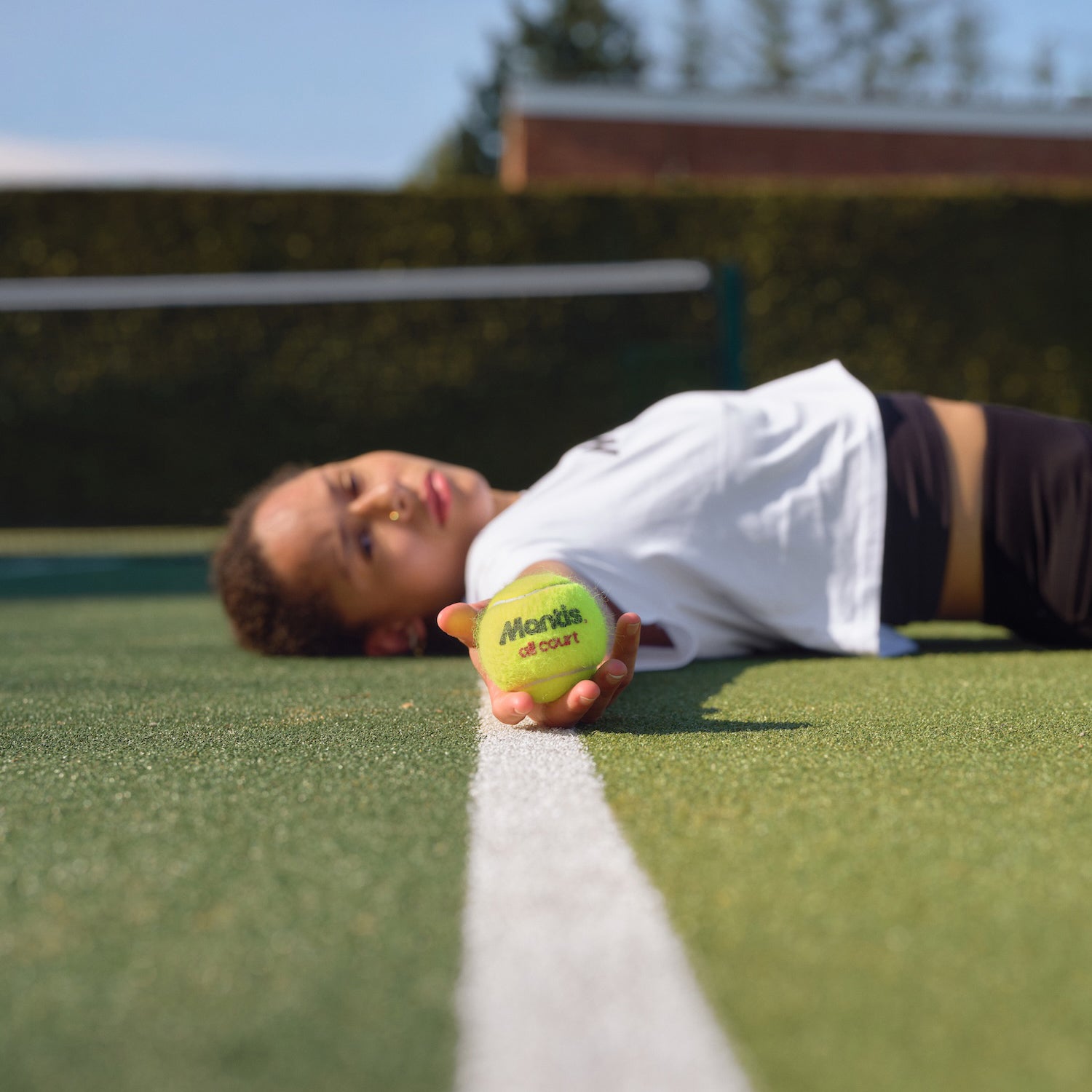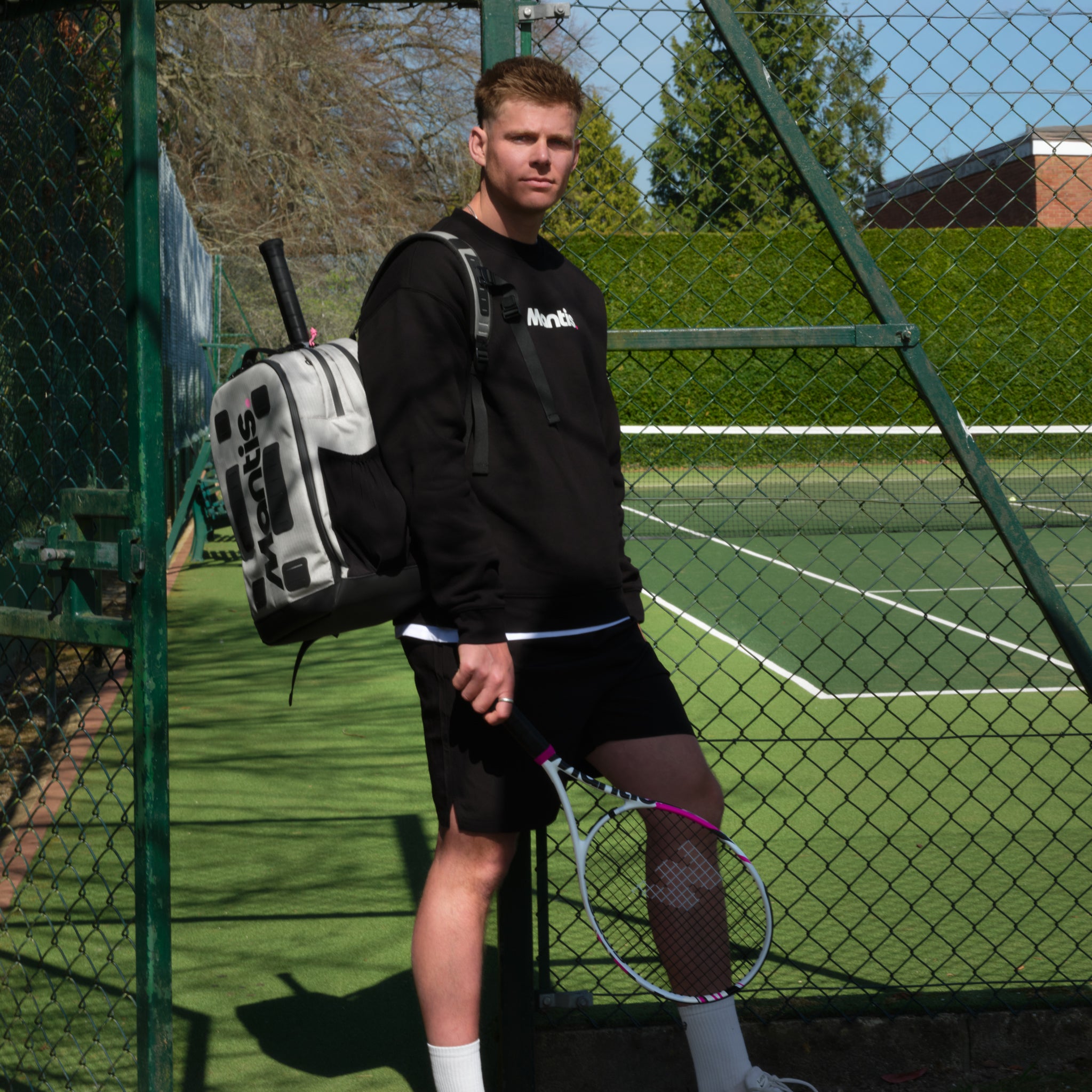
Why Your Grip Changes Everything
Many players don't realise that their grip is so much more than just how they hold the racket. It's the very foundation of your game, the difference between effortless power and a constant fight for consistency. Think of it as the gearbox in a car; without the right gear, all the engine power in the world is wasted. Learning how to grip a tennis racket correctly is your first real step towards unlocking the potential of every shot, from hitting heavy topspin forehands to playing a delicate drop volley. Your grip directly controls the angle of the racket face at impact, which is the single biggest factor in where the ball goes.

From Power to Injury Prevention
Beyond just shot mechanics, your grip is crucial for staying healthy on the court. A surprising number of recurring aches and pains, especially the dreaded tennis elbow, can be traced back to a poor grip or simply holding on too tight. Squeezing the handle creates tension and rigidity in your arm, preventing the natural, fluid motion needed for an efficient swing. This tension also magnifies the shock transferred to your forearm.
In fact, some UK tennis studies have shown that a tight grip significantly amplifies the vibrations that travel up the arm—a leading cause of overuse injuries.
A Dynamic and Adaptable Tool
Ultimately, the best players don't just have one fixed grip. They see it as a dynamic tool they can adapt to any situation the match throws at them. While we're focusing on tennis grips here, it can be helpful to understand how other racket sports differ. For example, looking into the key differences between how to grip a tennis racket and a padel bat really highlights why tennis requires such versatile and precise grip work. Mastering this fundamental skill isn’t just about avoiding bad habits; it’s about building a solid base for a more powerful, consistent, and injury-free game.
Getting Your Grip Size Right
Before we dive into the different methods of how to grip a tennis racket, let's talk about something fundamental: making sure the racket actually fits your hand. Trying to play with a grip that’s too big or too small is a bit like running a marathon in shoes that don't fit; it’s uncomfortable, compromises your form, and can lead to real frustration. An ill-fitting grip makes learning how to grip a tennis racket properly a non-starter, often causing hand fatigue and unpredictable shots.

Simple Ways to Measure Your Grip
So, how do you find your perfect match? There are a couple of classic methods that players and coaches have trusted for years.
- The Index Finger Test: This is a quick and easy check you can do anywhere. Hold the racket with your dominant hand using an Eastern grip (think of it like you're shaking hands with the handle). Now, try to slide the index finger of your other hand into the gap between your fingertips and your palm. If your finger fits snugly, you're in good shape. If there's no room at all, the grip is too small. A large gap means it's too big.
- The Ruler Test: For a more precise measurement, grab a ruler. Open your dominant hand flat, with your fingers together. Measure from the middle crease of your palm up to the tip of your ring finger. That length in inches is your grip size.
These methods are widely recommended across the UK to ensure players have maximum comfort and control. Guidance from the Lawn Tennis Association highlights that standard UK sizes usually fall between 4 1/8 inches for smaller hands and 4 1/2 inches for larger hands.
If you happen to fall between two sizes, our advice is always to go for the smaller one. It's much easier to build up the handle with an overgrip to get that perfectly customised feel. For a more detailed breakdown, have a look at our complete guide on tennis racket grip sizes to find what suits your game.
Mastering the Continental Grip
Think of the Continental grip as your Swiss Army knife on the court. It's the one grip you’ll come back to time and again for serves, volleys, overheads, and slices. A lot of coaches call it the "hammer grip," which is a great way to think about it. If you were to hammer a nail into a piece of wood using the side of your racket frame, you’d instinctively hold the handle in a Continental grip. It’s a natural starting point that helps you understand how to grip a tennis racket for better feel and control, especially when you're up at the net.
Finding the Right Position
To get a bit more technical, when going into detail on how to grip a tennis racket we need to talk about the bevels on your racket handle. If you look down at the butt of your racket, you'll see it’s an octagon. Let's number the top bevel as 1 and move clockwise from there. To find the Continental grip, place the base knuckle of your index finger squarely on bevel 2. Your palm should rest naturally along the handle, with your fingers slightly spread for a hold that’s firm but not tight.
This neutral position keeps the racket face slightly open, which is exactly what you need for shots where you have to get under the ball, like slices and volleys. It can feel a bit strange for groundstrokes at first, which is why some players try to avoid it, but it’s absolutely essential for developing an all-round game. If you're interested in how grips and frames work together, you can learn more about advanced racket technology.
To help you visualise where your hand should go when you're trying to learn how to grip a tennis racket with a continental position, take a look at the table below. It breaks down why the Continental is so useful for specific shots compared to other grips. (The USTA offers a handy video on the subject)
How to Grip a Tennis Racket By Shot Type
| Shot Type | Continental Grip | Alternative Grip | Advantage |
|---|---|---|---|
| Serve | Essential. Allows for natural wrist pronation, generating power and spin. | Eastern Forehand | The Continental is superior for creating a fluid, powerful service motion. |
| Volley | Ideal. Provides a stable, slightly open racket face for quick reactions. | Eastern Forehand/Backhand | Eliminates the need to change grips at the net, making you much faster. |
| Slice | Perfect. Keeps the racket face open to get under the ball and create backspin. | Eastern Backhand | Offers more feel and control for slicing than a more closed-face grip. |
| Overhead | Recommended. Similar mechanics to the serve; allows for a natural swing. | Eastern Forehand | Promotes a full, powerful swing without putting unnecessary strain on the wrist. |
As you can see, not having to switch grips for volleys, serves, and overheads saves you precious time and makes your game much more fluid.
The infographic below shows the hand placement for a Semi-Western grip, but the method of using the bevels as a guide applies to finding any grip.

By learning to identify the correct bevel and placing your knuckle there consistently, you’re building a reliable foundation. This muscle memory is what allows you to find the right grip without even thinking about it during a fast-paced point.
Unlocking Eastern and Semi-Western Power
Once you've got the hang of the versatile Continental, it's time to explore the grips that really define the modern, aggressive baseline game. The Eastern and Semi-Western grips are your ticket to hitting groundstrokes with serious power and heavy topspin. If you're figuring out how to grip a tennis racket for a forehand that really kicks up off the court, this is where you should focus.
Don't worry if these grips feel a bit odd at first, especially if you're used to a flatter hitting style. You'll notice the racket face feels naturally more closed, pointing slightly towards the ground. That's not a mistake; it's exactly what you want for generating spin.

Finding Your Forehand Grip
Let's go back to using the bevels on your racket handle as our map. As a reminder, the top flat surface is bevel 1, and we count clockwise from there.
-
The Eastern Grip (Bevel 3): People often call this the "shake hands" grip, and it's easy to see why. Just place the base knuckle of your index finger right on bevel 3. This setup gives you a brilliant mix of power and feel. It’s a very adaptable grip, letting you flatten out a shot to hit a winner or create a good amount of topspin. It’s a real favourite among all-court players who need to switch from defence to attack in a heartbeat.
-
The Semi-Western Grip (Bevel 4): To really load up on topspin, slide your knuckle one more bevel clockwise to bevel 4. This grip is the true engine of modern tennis. Because it closes the racket face even more before you swing, it encourages you to brush right up the back of the ball. The result is some serious topspin, perfect for hitting high, heavy shots that force your opponent well behind the baseline.
When to Use Each Grip
The choice between Eastern and Semi-Western often depends on where you are on the court and what kind of player you are. The Eastern grip is superb for hitting flatter, driving shots and is much more forgiving on balls that stay low. It's ideal for striking the ball cleanly when it’s bouncing around waist height.
On the other hand, if you like to play from further back and get into long rallies with high-bouncing balls, the Semi-Western grip is a game-changer. It gives you the margin for error you need to bring the ball down into the court with heavy rotation. The main trade-off is that it can be tricky to handle very low shots, as the closed racket face makes it tough to get under the ball.
Finding Your Perfect Grip Pressure
Here’s a detail where so many players accidentally sabotage their own game: grip pressure. If you squeeze the handle like you’re trying to get juice out of it, you create tension that completely kills your natural, fluid swing. On the other hand, if you hold it too loosely, you risk the racket twisting in your hand at that crucial moment of impact. The secret isn't finding one magic pressure level, but realising that it should change throughout your swing.
From a Death-Grip to Dynamic Control
You’ve probably heard the old coaching tip to hold the racket like you would a small bird—firmly enough so it can’t escape, but gently enough not to harm it. This analogy is perfect for the relaxed state you want your hand to be in before you even start your swing.
As you prepare and then execute the shot, your grip will naturally tighten slightly at the point of impact before relaxing again into the follow-through. This dynamic shift in pressure is what you're aiming for. A common myth is that a tighter grip equals more power, but in reality, it just tenses up your forearm and wrist, actually slowing down your racket head.
The Science of a Light Touch
Interestingly, biomechanical studies show just how little your grip force matters during the ball's actual impact, a moment which lasts a tiny 5 milliseconds. In that incredibly short window, your hand pressure has a minimal effect on the ball's speed or where it goes.
What really matters is the pressure you apply just before impact. This has a significant link to the racket vibrations you feel after the hit, accounting for roughly 25–36% of the difference. This means starting your swing with a relaxed grip can lead to a much cleaner feel and fewer jarring vibrations travelling up your arm. To see the data for yourself, you can explore the full findings on racket performance here.
Getting the pressure right not only helps your shots but also changes how your equipment feels in your hand. It's a bit like how different strings can completely alter your racket's response. If you're curious about that side of things, have a look at our guide on how to choose the right tennis strings.
Breaking Bad Grip Habits
It's a common story on the court: even players with years of experience can develop bad grip habits, often without even realising it. These sneaky patterns can quietly limit your power, consistency, and shot variety, becoming the frustrating reason behind those unforced errors. The main cause? Comfort. When you're under pressure, it's natural to revert to what feels most familiar, even if it's the wrong tool for the job. A classic example is sticking with an Eastern forehand grip for a slice backhand, which sends the ball floating instead of giving you that sharp, biting action.
Identifying Hidden Grip Issues
Learning how to grip a tennis racket correctly is a continuous journey of self-correction. The first part of fixing a problem is spotting the warning signs. Are you constantly framing your volleys or shanking your overheads? Do your shots lack spin when you're trying to play with a bit more safety? These issues aren't always a sign of poor technique; they often point directly to a grip problem.
A lot of players develop a "pancake" grip—using a full Western for everything—which absolutely kills their net game and makes digging out low balls almost impossible. Another frequent mistake is gripping too high or too low on the handle, throwing off the racket's balance and your sense of control.
Check your own hand placement against this guide to see if you’ve drifted into a less effective, hybrid position. Breaking these habits takes conscious effort. A great starting point is to shadow-swing in front of a mirror, focusing on changing your grip between imaginary shots. Then, take that deliberate practice to the court. It’s all about building new muscle memory, which demands patience but the payoff is enormous.
Building Automatic Grip Changes
Knowing how to form a Continental or Semi-Western grip is one thing. Being able to switch between them mid-rally without a second thought is what truly elevates your game. This is the skill that separates a reactive player, who’s always scrambling, from a fluid one, who seems to have all the time in the world.
This instinct isn’t some secret talent reserved for the pros. It’s a skill built through focused, deliberate practice. It's less about hitting a thousand balls and more about making every repetition count. With the right approach, you can train your hands to find the right grip automatically, freeing up your mind to focus on strategy and shot selection.
Off-Court Drills for Muscle Memory
You don’t even need a court to start building this reflex. A few minutes in your living room each day can work wonders for ingraining the physical movements into your muscle memory.
- Shadow Swings with Transitions: Grab your racket and stand in front of a mirror. Perform a full forehand shadow swing using your preferred grip (perhaps an Eastern or Semi-Western). As you recover, immediately shift your hand into a Continental grip for a follow-up volley. Watch your hand closely in the mirror. Is your index knuckle hitting the right bevel every single time? The visual feedback is crucial here.
- The "Racket Spin" Drill: This one is fantastic for developing feel. Hold the racket out in front of you by the handle. Gently spin the frame with your non-dominant hand and practice stopping its rotation by grabbing it with your hitting hand, instantly forming a specific grip. Call it out first—"Continental!"—and grab. Then, "Eastern!" and grab. This drill forces your hand to recognise the shape of the grip without looking.
How to grip a tennis racket: On-Court Progression
Once the grip changes start to feel more familiar off-court, it's time to introduce a ball. The key is to progress slowly to avoid falling back into old habits under pressure.
Start with simple, predictable feeding drills. Have a partner or a coach feed you a sequence of shots, for example, a deep forehand followed by a short volley. Because you know what's coming, you can dedicate all your mental energy to one thing: making the grip change as you prepare for the shot, not while you're swinging. This should happen as you turn your shoulders and start your take-back.
As you get more comfortable, you can progress to drills with more variety and less predictability. The goal is to gradually add complexity until the grip change is completely automatic, even in a fast-paced rally.
To help players master these transitions, a well-defined racket handle is essential. At Mantis, we design our rackets with a clear bevel structure to provide distinct tactile feedback, making it easier for your hand to find its home for every shot. You can explore gear built for purposeful improvement at Mantis Sport.
To help structure your practice, here is a progressive training plan you can follow.
Grip Development Training Schedule
This 4-6 week plan is designed to progressively build your grip technique from the ground up, moving from conscious effort to automatic execution.
| Week | Focus Area | Daily Practice Time | Key Exercises | Success Indicators |
|---|---|---|---|---|
| 1 | Foundation & Feel | 10-15 mins | Racket Spin Drill, Shadow Swings (single grip), identifying bevels with eyes closed. | You can consistently find Continental & Eastern grips by feel without looking at your hand. |
| 2 | Basic Transitions (Off-Court) | 10-15 mins | Shadow Swings with Transitions (Forehand to Volley), practicing changes between all 3 grips. | Transitions feel smoother and faster. You are no longer "thinking" about every hand movement. |
| 3 | Controlled On-Court Practice | 15-20 mins | Partner feeding drills (alternating forehands/volleys), mini-tennis focusing on grip changes. | You are changing grips during the preparation phase, before the ball bounces. |
| 4 | Dynamic On-Court Drills | 15-20 mins | "Cross-court Rally to Net-Rush" drill, drills with unpredictable feeds from a partner. | Grip changes are happening automatically without conscious thought during rallies. |
| 5-6 | Integration & Match Play | During warm-ups | Focus on grip awareness during practice points and match play. Self-correct when you notice an error. | You use the correct grip for various shots in a competitive situation without compromising technique. |
By the end of this schedule, the process of changing grips should feel second nature. You'll have built the muscle memory needed to play with more variety, confidence, and effectiveness on the court.
If you still have questions about how to grip a tennis racket then you can contact an expert at Mantis








